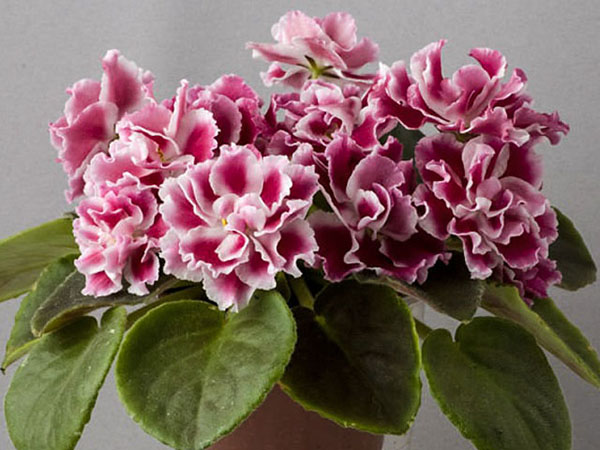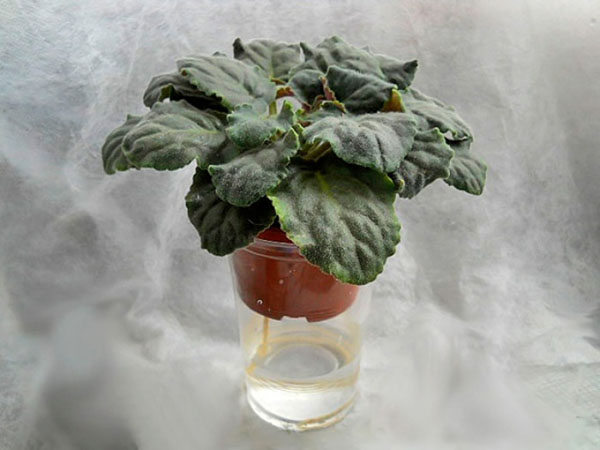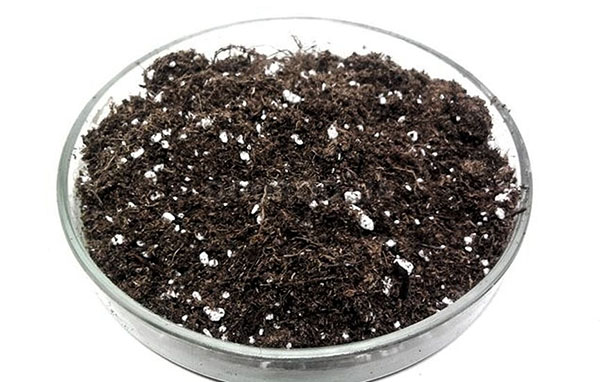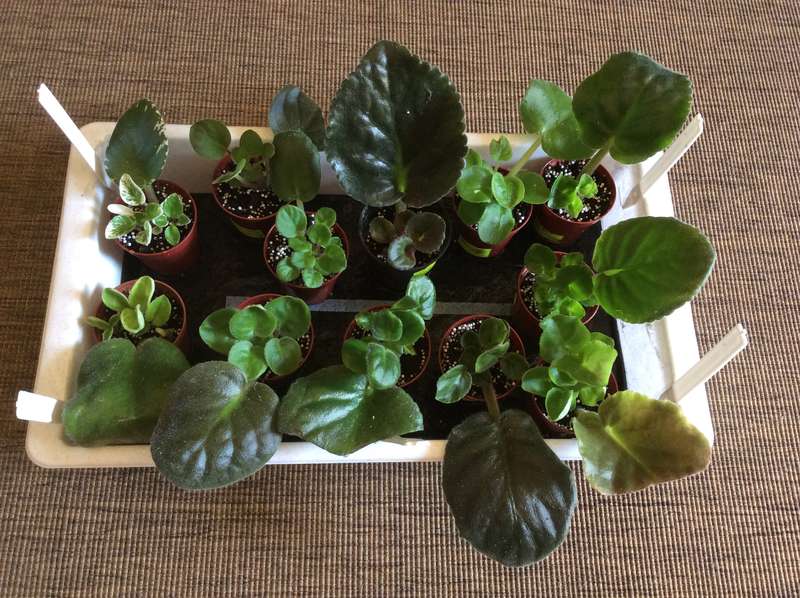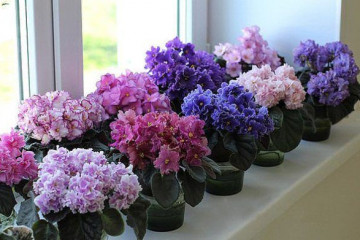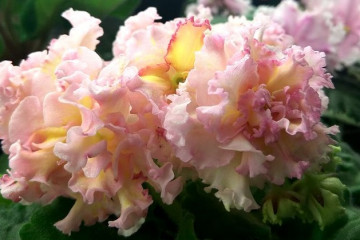Violet Frosty cherry - description and characteristics of the variety
Content:
Violet Frosty cherry charms with the brightness and contrast of the flower, as well as unpretentiousness and long, lush bloom. This variety was presented to the world by the Russian breeder Konstantin Morev.
Appearance
Like other members of the Gesneriev family, violet leaves are covered with soft short hairs. Saintpaulia Frosted Cherry has a neat rosette with simple quilted green leaves that become slightly darker with age.
But the flower of this variety cannot be called simple. Cherry strokes stand out against a bright white background, the wavy edge of the petal gives the composition an airiness. The duration and abundance of flowering will delight any grower.
To get a new variety, breeders cross and select the best specimens, and then test the plant for trait resistance. It took Konstantin Lvovich 11 years to get the desired result, and in 2005 the Frosty Cherry violet was introduced as a new variety.
Since then, for a long time, the "cherry" has not lost its popularity and is in constant demand among flower growers.
Features of caring for a violet Frosty cherry at home
The well-being and appearance of violets depends on the ability of the grower to meet their needs for watering, lighting and nutrition. Under optimal conditions, violets bloom for nine months a year.
Temperature
The violet can tolerate a short-term drop in temperature up to 12 ° C, but for normal development it needs warmth. The plant feels comfortable if the thermometer shows 20-22 degrees Celsius.
Sharp temperature fluctuations are contraindicated in the flower.
Lighting
For placing violets, windows of east or west orientation are most suitable. To get an even rosette, the flower is periodically rotated. If saintpaulia is placed far from the window, they provide additional illumination.
With a lack of lighting, leaf cuttings stretch and rise, and the color of leaves and flowers loses saturation and brightness. Direct sunlight can cause burns on the leaves, so the plant is shaded from excessively bright light.
Watering
You can provide violets with moisture in different ways: using wick irrigation, pouring into a tray or from above.
Wick watering will help the florist save time. In this case, a lace is placed in the pot, passing it through the drainage hole. The outward part of the wick is lowered into a container with water.
When using the "bottom watering" method, water is poured into the pan for 20 minutes, then the excess is drained. Most often, this method is used in greenhouses for mass cultivation of Saintpaulias, but it can also be used in indoor floriculture.
Most often, ordinary people water home violets from above, gently moistening the earthen lump. In this case, certain rules must be observed:
- Water if the surface of the soil in the flower pot is dry. The frequency of watering is different at different times of the year.In winter, you can moisten the plant 2-3 times a week, and in summer this procedure is carried out daily.
- It is advisable to use settled water at room temperature.
- Moisten the plant evenly, trying not to create stagnant moisture and not leave dry areas.
- Excess water is drained from the pan after a quarter of an hour.
Humidity
The most suitable humidity for growing Saintpaulias is 50%. In a drier atmosphere, the flowers will be slightly smaller and the leaves will be denser.
The heating season is a critical time for Frosty cherry, especially if the flower is located near the batteries. Hot air currents negatively affect the plant, its leaves begin to turn yellow.
To humidify the air, plants are placed in a tray with wet expanded clay or moss, or containers filled with water are placed next to the pots.
The presence of a humidifier or air washer in the apartment completely removes the problem of achieving the required humidity.
Priming
The delicate roots of violets are very sensitive to the soil. Therefore, when choosing a substrate, you need to remember that it must be loose and nutritious. When compiling a land mixture, violets often use peat and agroperlite with the addition of crushed moss. Peat (or light garden soil) is a filler. Perlite (like vermiculite, sphagnum, sand) acts as a baking powder, providing good moisture holding capacity and air permeability. You can also add nutritious compost soil or humus.
As for the exact proportions, there are many recipes. For example, in the book of the famous breeder Boris Mikhailovich Makuni the following description:
- high-fiber coarse peat - 2 parts;
- sphagnum moss and sod land - one part each;
- river sand - 0.5.
To do this, you can spill the soil with boiling water or a strong solution of potassium permanganate. Sometimes the land mixture is frozen, which also helps to get rid of harmful insects.
Florists who do not have a large margin of time use commercial components sterilized in an industrial way, or ready-made mixtures for Saintpaulias.
Top dressing
Violet cherry, like other plants that are in a limited amount of substrate, needs regular feeding. However, it should be borne in mind that too concentrated solutions are harmful to plants. Violets tolerate a lack of fertilizer better than an excess. For Saintpaulia, a solution in a concentration of 1 g of complex mineral salts per 1 liter of water is considered optimal. This feeding is carried out every 2-3 weeks.
In addition, an excess of potassium leads to a cessation of growth, and an excess of nitrogen, on the contrary, promotes the growth of green mass to the detriment of flowering. Therefore, nitrogen fertilizers are suitable for children, and phosphorus fertilizers are chosen for plants with buds.
Usually, complex fertilizers with a low nitrogen content are used for violets. It is useful to alternate mineral and organic feedings. After transplanting, no fertilizer is applied to fresh soil for two weeks. During the dormant period, the plant is also not fertilized.
The application of Osmocote prolonged-release fertilizers saves time and gives a visible effect. The granules are placed in a pot during transplanting and within a few months, under the influence of water, trace elements are released and nourish the plants.
Blooming frosty cherry
The variety, which is not greedy for flowering, pleases with beautiful flowers almost all year round. In winter, it is recommended to create a dormant period for a couple of months, reduce watering and do not light up.After that, you need to create favorable conditions for growth - and soon an elegant bouquet will form. Peduncles appear in the axils of the leaves, each bearing several flowers. Mature plants are prone to cap flowering.
Double flowers, rather large, with wavy petals. Large cherry spots stand out against a white background. Bright, contrasting color is the hallmark of the variety. Frosty cherries, like the winter cherry violet, react to high temperatures.
To extend the duration of flowering, do not forget a few simple rules:
- It is important to provide the violet with good lighting. With a lack of light, the flowers fade, and the leaves and flower stalks stretch out.
- Withered peduncles must be removed.
- For flowering plants, the day length should be 12 hours.
- During budding and flowering, violets need feeding and frequent watering.
Very rarely there are specimens with a deviation from varietal flowering, the so-called sports. Some flowers completely turn cherry blossoms, losing their white color. Occasionally there are deviations in the color of the leaves - variegation appears. There is a beautiful sport of Frosty Cherry with dark velvety petals and a thin white crisp border.
The nuances of reproduction and transplantation
Seed propagation of violets is a very laborious process. The flower is pollinated, the seed pods are waiting for the ripening and tiny seeds are sown in the greenhouse. It will take at least a year to wait for flowering, and the result is unpredictable. Seedlings can repeat the flowering of their parents, but flowers often appear that differ in color and doubleness.
The most common breeding method is by leaf cuttings. A healthy large leaf is cut off with a clean knife and placed in a glass of water or directly into the ground. It is recommended to cover the sheet with a bag or jar. When the babies that appear reach 1/3 of the mother's leaf in size, they are placed in separate pots. Such plants retain all varietal characteristics and bloom for 8-9 months from the moment of rooting.
If the roots of Saintpaulia have filled the pot, it is transplanted into a container of slightly larger diameter. Adult plants are transplanted once a year, young ones every 3 months. Violets love fresh substrate and respond to transplantation with active growth or budding.
Possible growing problems
Healthy violets delight the eye and evoke a lot of positive emotions. Unfortunately, weakened specimens are susceptible to diseases and attacks of harmful insects.
The most common pests are cyclamen mites and thrips.
- The tick is not visible to the naked eye. It settles at the point of growth, as a result, the center of the rosette is deformed and covered with a gray fluff. The flowers wither and the leaves become brittle. To combat ticks, use Actellic or Nissoran.
- Thrips is a small, rapidly multiplying insect. Signs of damage by this pest are spots, plaque and holes in the leaf plates. Get rid of thrips with the help of preparations "Akarin", "Confidor".
Frosty cherries can be affected by powdery mildew. This is a fungal disease in which a white coating appears on the leaves and stems. The plant is treated with Fundazol.
The cause of the appearance of spots on the leaves can also be improper care. Too large a pot, bright direct sun, excessive watering - all this causes a failure in the development of Saintpaulias. Bringing up containment conditions solves this problem.
Violet Frosty cherry requires some effort to organize optimal conditions for it.But it pays off with a vengeance of bright and abundant flowering for many months.
